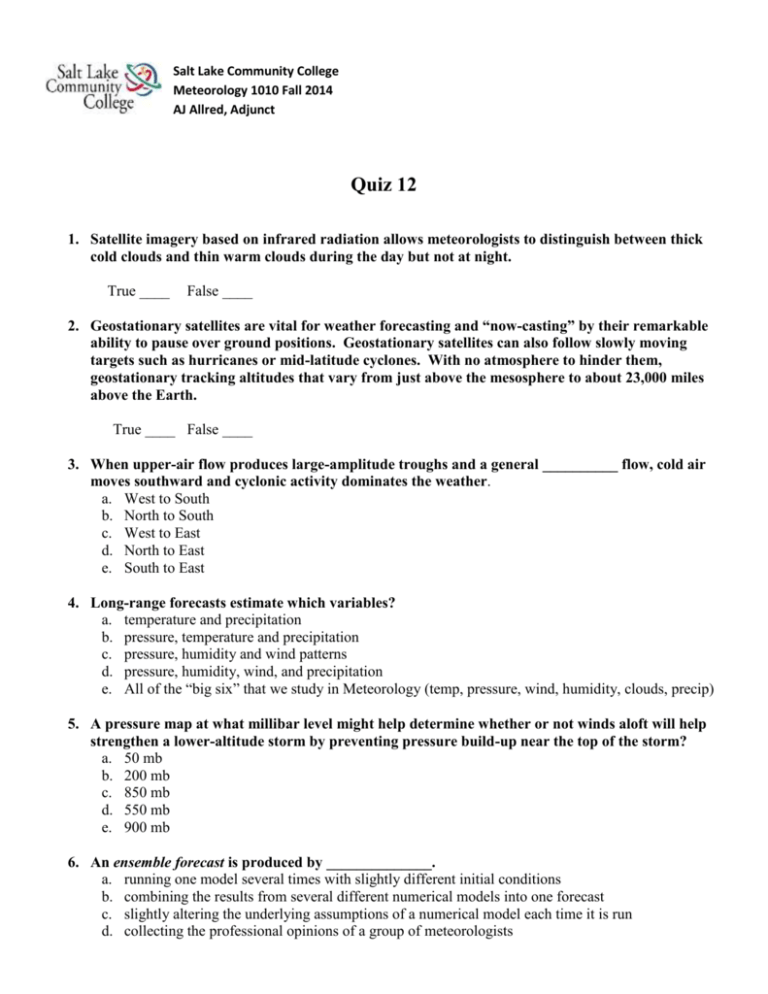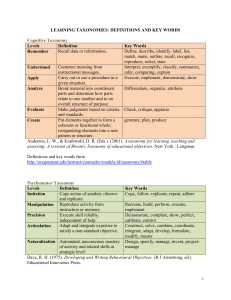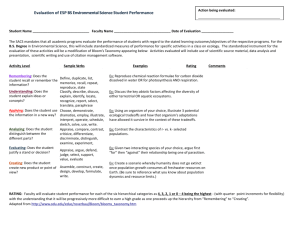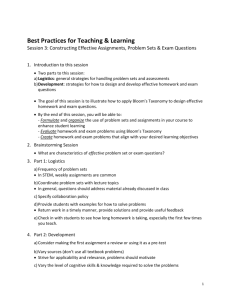Quiz 12 - SmartMap.us
advertisement

Salt Lake Community College Meteorology 1010 Fall 2014 AJ Allred, Adjunct Quiz 12 1. Satellite imagery based on infrared radiation allows meteorologists to distinguish between thick cold clouds and thin warm clouds during the day but not at night. True ____ False ____ 2. Geostationary satellites are vital for weather forecasting and “now-casting” by their remarkable ability to pause over ground positions. Geostationary satellites can also follow slowly moving targets such as hurricanes or mid-latitude cyclones. With no atmosphere to hinder them, geostationary tracking altitudes that vary from just above the mesosphere to about 23,000 miles above the Earth. True ____ False ____ 3. When upper-air flow produces large-amplitude troughs and a general __________ flow, cold air moves southward and cyclonic activity dominates the weather. a. West to South b. North to South c. West to East d. North to East e. South to East 4. Long-range forecasts estimate which variables? a. temperature and precipitation b. pressure, temperature and precipitation c. pressure, humidity and wind patterns d. pressure, humidity, wind, and precipitation e. All of the “big six” that we study in Meteorology (temp, pressure, wind, humidity, clouds, precip) 5. A pressure map at what millibar level might help determine whether or not winds aloft will help strengthen a lower-altitude storm by preventing pressure build-up near the top of the storm? a. 50 mb b. 200 mb c. 850 mb d. 550 mb e. 900 mb 6. An ensemble forecast is produced by ______________. a. running one model several times with slightly different initial conditions b. combining the results from several different numerical models into one forecast c. slightly altering the underlying assumptions of a numerical model each time it is run d. collecting the professional opinions of a group of meteorologists 7. What is the air temperature represented on the station model shown below? a. 75°F b. 75°C c. 69°F d. - 20°C e. 105°F 8. For the station model shown in Question 8 above, what would be a likely weather forecast based on the number -20? a. winds that are diminishing or subsiding b. temperature dropping c. clouds giving way to clear skies d. dew point temperature e. increasing wind speed 9. Synoptic weather maps display weather data that _______________. a. show multiple levels of the atmosphere on the same chart. b. were measured at the same time. c. were measured at the same place. d. were measured by a satellite. e. were calculated by a mathematical model. 10. Which of the following upper air maps is most useful for observing the details of the polar jet stream? a. 1000mb map b. 850mb map c. 500mb map d. 300mb map e. 100mb map 11. On a surface-level synoptic weather chart, a front is often identified by zones that exhibit _______ a. strong jet stream flow. b. clear skies. c. gradual changes in pressure. d. abrupt changes in temperature, humidity and wind direction. e. All of the above. 12. The accuracy of day-to-day weather forecasts for periods beyond ________ hours is relatively unreliable. a. 12 b. 24 c. 96 d. 128 e. 168 13. A station model that is updated to show an increasing spread or difference between dew point temperature and actual temperature suggests that _______________. a. temperature is rising b. c. d. e. temperature is falling the chance of fog is increasing fog formation is less likely wind speed is likely to increase 14. In order to demonstrate true skill, a forecaster must do a better job than a. a climate-based prediction. b. Analog processing c. Persistence tracking d. prog chart and model output statistics e. numerical processing 15. Which of the following rely on the fact that gases of the atmosphere obey a number of known physical principles to predict the future state of the atmosphere? a. numerical weather prediction b. statistical methods c. trend forecasting d. persistence forecasting e. model output statistics 23) The development of large, fast computers has allowed this method of weather prediction to become useful. A) nowcasting B) numerical C) persistence D) analog e. climate Answer: B Page Ref: 333 Bloom's Taxonomy: Evaluate Nat. Geog. Stand: 1: Maps and Other Geographic Representations 24) A prognostic chart: A) is used to pinpoint the current location of fronts. B) is used to explain the causes of thunderstorms as they are happening. C) evaluates past weather conditions to predict future ones. D) displays numerical forecasts for future conditions in precipitation, wind speed, and upper air flow. Answer: D Page Ref: 333 Bloom's Taxonomy: Remember Nat. Geog. Stand: 1: Maps and Other Geographic Representations 25) One commonly used way to improve a numerical model forecast is to: A) reformulate the model after every forecast to correct errors. B) statistically assess errors that the model makes repeatedly and adjust the forecast accordingly. C) eliminate portions of the model that aren't contributing to the forecast. D) simplify the model's assumptions. Answer: B Page Ref: 333 Bloom's Taxonomy: Understand Nat. Geog. Stand: 1: Maps and Other Geographic Representations Page Ref: 333 Bloom's Taxonomy: Remember Nat. Geog. Stand: 1: Maps and Other Geographic Representations 27) ________ predict(s) that future weather will be the same as the present weather conditions. A) The analog method B) Persistence forecasts C) Trend forecasting D) Nowcasting Answer: B Page Ref: 334 Bloom's Taxonomy: Remember Nat. Geog. Stand: 7: Physical Processes that Shape Earth Answer: B Page Ref: 330 Bloom's Taxonomy: Remember Nat. Geog. Stand: 1: Maps and Other Geographic Representations 12) The word synoptic literally means: A) coincident in time. B) related to weather. C) of the same place. D) bird-eyed. Answer: A Page Ref: 330 Bloom's Taxonomy: Remember Nat. Geog. Stand: 1: Maps and Other Geographic Representations 15) Which of the following weather data is not always plotted in the same location with respect to the weather station? A) cloud type B) past weather C) barometric pressure D) pressure tendency E) wind direction Answer: E Page Ref: 331 Bloom's Taxonomy: Remember Nat. Geog. Stand: 1: Maps and Other Geographic Representations 19) The current sea level air pressure represented on the station model shown above is: A) 1010.5 mb B) 910.5 mb C) 1020.0 mb D) 969.0 mb Answer: A Page Ref: 331 Bloom's Taxonomy: Apply Nat. Geog. Stand: 1: Maps and Other Geographic Representations 20) What is the dew point represented on the station model shown above? A) -20°C B) 75°F C) 69°F D) 69°C Answer: C Page Ref: 331 Bloom's Taxonomy: Apply Nat. Geog. Stand: 1: Maps and Other Geographic Representations Answer: A Page Ref: 332 Bloom's Taxonomy: Remember Nat. Geog. Stand: 7: Physical Processes that Shape Earth Page Ref: 332 Bloom's Taxonomy: Understand Nat. Geog. Stand: 1: Maps and Other Geographic Representations 28) Successful short term forecasts (a few hours) can often be made using this method of prediction. A) analog forecasting B) climatological forecasting C) upper-wave forecasting D) probability forecasting E) persistence forecasting Answer: E Page Ref: 334 Bloom's Taxonomy: Remember Nat. Geog. Stand: 7: Physical Processes that Shape Earth 29) The current conditions in your location are sunny with a temperature of 85°F. Based on these observations, you forecast that in a few hours, it will be sunny with a temperature in the mid 80s. What kind of forecast have you issued? A) a numerical forecast B) a persistence forecast C) a statistical forecast D) an analog forecast Answer: B Page Ref: 334 Bloom's Taxonomy: Understand Nat. Geog. Stand: 7: Physical Processes that Shape Earth 30) A farmer is trying to determine which kind of seed he should plant. He consults a(n) ________ in order to determine the length of his growing season and average rainfall in order to make the best choice. A) analog forecast B) persistence forecast C) climatological forecast D) numerical forecast Answer: C Page Ref: 335 Bloom's Taxonomy: Understand Nat. Geog. Stand: 1: Maps and Other Geographic Representations 31) You'd like to plan a Christmas day flight to visit family. You have several months lead time. How might you determine the probability of snowfall occurring and potentially interfering with your travel plans? A) Consult a climatological forecast. B) Watch the Weather Channel to hear the latest numerical forecast. C) Refer to the analog forecast published by the NWS. D) Roll the dice - no one can forecast that. Answer: A Page Ref: 335 Bloom's Taxonomy: Understand Nat. Geog. Stand: 1: Maps and Other Geographic Representations 32) In numerical weather prediction, what is the hydrostatic equation used to describe? A) changes in atmospheric density B) vertical motion in the atmosphere C) the impacts of changing temperature D) horizontal advection Answer: B Page Ref: 336 Bloom's Taxonomy: Remember Nat. Geog. Stand: 1: Maps and Other Geographic Representations 33) What is a typical time-step for a numerical weather model? A) 30 seconds B) 5 minutes C) 30 minutes D) 1 hour Answer: B Page Ref: 336 Bloom's Taxonomy: Remember Nat. Geog. Stand: 1: Maps and Other Geographic Representations 34) Which technique is used that attempts to match current conditions with similar well established patterns from the past? A) persistence forecasting B) trend forecasting C) isotachs method D) analog method Answer: D Page Ref: 337 Bloom's Taxonomy: Understand Nat. Geog. Stand: 1: Maps and Other Geographic Representations 35) ________ assume(s) that the weather occurring upstream will persist and move on to affect the area in its path. A) Trend forecasting B) Nowcasting C) The analog method D) Persistence forecasts Answer: A Page Ref: 337 Bloom's Taxonomy: Remember Nat. Geog. Stand: 7: Physical Processes that Shape Earth 36) Why is the pattern of upper-level winds an important part of the forecasting process? A) Rainfall at the surface corresponds to westerly flow aloft. B) It strongly influences the development of surface storms. C) Surface pressure controls the wind aloft. D) Jet streams aloft always lead to storms. Answer: B Page Ref: 337 Bloom's Taxonomy: Understand Nat. Geog. Stand: 7: Physical Processes that Shape Earth 38) Nowcasting: A) is not very useful for predicting thunderstorms and tornadoes. B) makes extensive use of radar and geostationary satellites. C) makes little use of numerical data. D) is primarily used for making long-range forecasts for large regions. Answer: B Page Ref: 337 Bloom's Taxonomy: Remember Nat. Geog. Stand: 1: Maps and Other Geographic Representations 39) The winds at the ________ level are the steering mechanism for air mass thunderstorms. A) 850-mb B) 700-mb C) 500-mb D) 300-mb Answer: B Page Ref: 338 Bloom's Taxonomy: Remember Nat. Geog. Stand: 7: Physical Processes that Shape Earth 41) Airflow aloft is often illustrated with ________, lines of equal wind speed. A) isotachs B) isobars C) isovels D) isometers Answer: A Page Ref: 339 Bloom's Taxonomy: Remember Nat. Geog. Stand: 1: Maps and Other Geographic Representations Answer: D Page Ref: 339 Bloom's Taxonomy: Remember Nat. Geog. Stand: 1: Maps and Other Geographic Representations 43) When the upper-air exhibits a general ________ flow, cyclonic systems tend to move through quickly, creating rapidly changing weather conditions. A) West to South B) North to South C) North to East D) West to East Answer: D Page Ref: 340 Bloom's Taxonomy: Understand Nat. Geog. Stand: 7: Physical Processes that Shape Earth 49) In determining the occurrence of precipitation, the NWS forecasts are correct more than ________ percent of the time. A) 10 B) 30 C) 50 D) 80 Answer: D Page Ref: 344 Bloom's Taxonomy: Remember Nat. Geog. Stand: 1: Maps and Other Geographic Representations Answer: D Page Ref: 345 Bloom's Taxonomy: Remember Nat. Geog. Stand: 7: Physical Processes that Shape Earth 56) Infrared images provide a way to determine which clouds are more likely to produce what? A) humidity B) drought C) precipitation D) wind Answer: C Page Ref: 348 Bloom's Taxonomy: Remember Nat. Geog. Stand: 7: Physical Processes that Shape Earth 57) How can a satellite "see" water vapor in the atmosphere? A) The satellite is capable of sensing the wavelength of radiation typically emitted by water vapor. B) It can't see vapor — it can only identify places where vapor is condensing. C) It estimates vapor based on the temperature of the atmosphere. D) It measures solar radiation reflecting off of the water vapor. Answer: A Page Ref: 349 Bloom's Taxonomy: Understand Nat. Geog. Stand: 7: Physical Processes that Shape Earth 64) The measured data written on a synoptic chart is data that was all measured at the same time. Answer: TRUE Page Ref: 330 Bloom's Taxonomy: Remember Nat. Geog. Stand: 1: Maps and Other Geographic Representations 75) Smaller north-south temperature contrasts are associated with slower jet stream flow. Answer: TRUE Page Ref: 341 Bloom's Taxonomy: Understand Nat. Geog. Stand: 7: Physical Processes that Shape Earth 76) Larger north-south temperature contrasts occur in summer. Answer: FALSE Page Ref: 341 Bloom's Taxonomy: Remember Nat. Geog. Stand: 7: Physical Processes that Shape Earth 91) List three characteristics that are used to identify the location of a front on a synoptic weather chart. Answer: Marked temperature changes, wind direction changes, humidity (dew point) variations and cloud and precipitation patterns. Page Ref: 332 Bloom's Taxonomy: Remember Nat. Geog. Stand: 1: Maps and Other Geographic Representations 94) Long-range forecasting employs this method: ________. Answer: statistical methods of weather prediction Page Ref: 343 Bloom's Taxonomy: Remember Nat. Geog. Stand: 1: Maps and Other Geographic Representations








